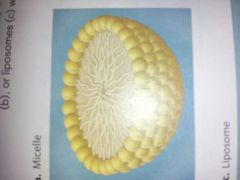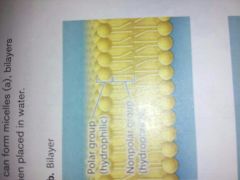![]()
![]()
![]()
Use LEFT and RIGHT arrow keys to navigate between flashcards;
Use UP and DOWN arrow keys to flip the card;
H to show hint;
A reads text to speech;
28 Cards in this Set
- Front
- Back
|
What is cell theory ?
|
All living organisms are made up of cells , cells come from preexisting cells , anf cells are the smallest unit of life.
|
|
|
What defines a cell and what separates it from its environment ?
|
Membranes separate a cell from its external environment and defines a cell .
|
|
|
What are some of the components of a cell membrane ?
|
lipids are the main component, proteins are embedded in lipids or associated with them and carbohydrates usualy attached to glycoproteins or glycolipids.
|
|
|
What are the major types of lipids found in cell membranes ?
|
phospholipids are commonly found in the makeup of cell membranes.
|
|
|
What is special about phospholipids?
|
phospholipids are amphipathic meaning they have a hydrophobic and hydrophilic part and the phosphate head is the hydrophilic part while the legs are hydrocarbons fatty acid nonpolar.
|
|
|
What are micelles and how are they arranged ?
|

micelles are a group of phosphlipids that have a bulky phospho head compared to the single lipid tail that is wedge shaped.
|
|
|
What are bilayers ?
|

phosphoLipids with less bulky phospho head and two hydrophobic tails.
|
|
|
What is a liposome ?
|
liposomes are bilayer structure as a result of phospholipids in an aqueous environment.
|
|
|
What are some changes liposomes can go through ?
|
Liposomes can form and re-form, they can grow and they can incorporate nucleic acids and other molecules.
|
|
|
How did membranes from through time ?
|
All membranes have been assembled by physical proccesses and they work more on a principle of tinkering rather enignineering.
|
|
|
What makes cell membranes dynamic ?
|
there are van der wahls interactions with phospholipids resulting in the ability to move within the plane of a membrane.
|
|
|
As a result of what makes the cell memebrane fluid ?
|
Because phospholipids can move within a plane of a memebrane they are considered as fluid.
|
|
|
What determines fluidity in a cell memebrane ?
|
Depending on the type lipid makeup. If the lipids are saturated a result of single carbon hydrogen bonds, then the membrane will not be as fluid. If the cell memebrane is made up of unsaturated lipids a result of double bonds in carbon, the cell memebrane will have greater fluidity.
|
|
|
Besides phospholipids what other lipids are contained in animal cells?
|
Cholesterol accounts for 30% of the cell memebrane. cholesterol is also amphipathic and has a hydroxide group which is hydrophilic and 4 carbon rings with an attached hydrocarbon chain.
|
|
|
How does cholesterol bond with phospholipids ?
|
The hydroxide group of cholesterol attaches to the phosphates and the hydrophobic parts have van der wahls interactions with the fatty acids.
|
|
|
How does cholesterol affect membrane fluidity in a cell ?
|
Cholesterol at normal tempertures the carbon rings interact with other fatty acids therefore decreasing fluidity. However in cold temepratures cholesterol prevents phospholipids from packing tightly and therefore incereasing memebrane fluidity.
|
|
|
What are lipid rafts ?
|
Lipid rafts are specific types of lipids that assemble into defined patches.
|
|
|
What is a lipid flip flop ?
|
Lipid flip flop is when a lipid switches positions between bilayers which is very rare because this requires the hydrophilic head to pass through the hydrophobic tails.
|
|
|
What are the roles of proteins in the memebrane ?
|
Transporters such as channeling allowing molecules to enter and carriers that facilitate movement. receptors that signal, enzymes that catalyze reactions or anchors that give the cell structural support.
|
|
|
Integral membrane proteins.
|
They are permanentley associated with the membrane and cannot be separated without destroying the membrane.
|
|
|
peripheral membrane proteins
|
they interact with the bilayer and or with the integral membrane proteins that are bonded through noncovalent bonding.
|
|
|
What are transmembrane proteins and what three regions do they have ?
|
Transmembrane proteins are integral membrane proteins that span throughout the cell memebrane and they are made up of two hydrophilic regions which protrude from each of the membrane and a connecting hydrophobic region that spans in the membrane.
|
|
|
What do the hydrophilic transmembranes interact with?
|
The internal hydrophilic transmembrane interacts with other proteins within the cytoplasm and the external region interacts with signaling molecules.
|
|
|
Can proteins move in the plane of cell memebrane and how do we know if they do ?
|
Proteins like lipids are fluid in the cell memebrane. This has been proven using frap in which some proteins are made to absorb fluoresence and some not the end result showd that the fluoresence moved to the nonfluresence region.
|
|
|
Fluid mosaic model states?
|
The fluid mosaic models states that lipids and proteins are able to coexist in the cell memebrane and they are also free to move in the plane of the memebrane.
|
|
|
How are bilayered phospholipds arranged ?
|
the hydrophilic heads point towards the aqueous environment while the hydrophobic tails point towards each other away from the aqueous part resulting in a closed structure.
|
|
|
Why are bilayer memebranes self healing ?
|
because the phosphate heads spontanelously re arrange themselves due to their hydrophobic tails.
|
|
|
What could hinder a bilayer from forming in a cell ?
|
if the concentration of the phosphlipids is high and the ph is neutral.
|

